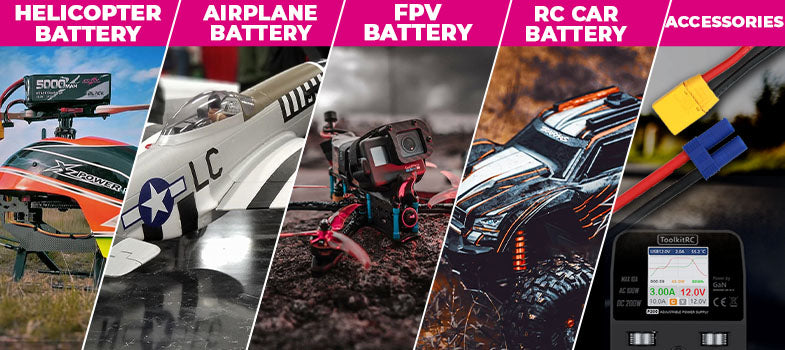
CNHL Lipo Batteries
CNHL aim at providing high-quality Li-Po batteries and RC products to all hobby enthusiasts with excellent customer services and competitive prices
If you’ve ever wondered how to keep your LiHV packs healthy for the long run, this guide covers charging, storage voltage, and the key differences vs. LiPo—with clear, real-world numbers.

Always connect the charge lead to the charger first, then connect the battery. Avoid unplugging the charge lead while the pack is still attached.
When you won’t fly/drive again soon, set the pack to ~3.80V per cell (aka storage voltage) using the charger’s storage function. Let the battery cool before storage and keep it in a dry, fire-safe place.
Voltage sags under load and rebounds at rest. To protect pack health:
Q1. Can I charge a LiHV pack using normal LiPo mode?
A: Yes, but it will stop at 4.20V/cell and you won’t use the full LiHV potential. For maximum capacity/performance, use LiHV mode (4.35V/cell).
Q2. What is the ideal storage voltage for a 6S LiHV?
A: About 22.8V total (≈3.8V × 6). In general: total storage voltage ≈ 3.8V × cell count.
Q3. What’s a safe minimum after each flight?
A: Land around 3.6–3.7V per cell (at rest). Avoid <3.5V per cell in normal use and avoid prolonged operation near ~3.3V.
Q4. Do I need to fully charge a new LiHV before putting it into storage?
A: No. You can directly set it to storage voltage (~3.8V/cell) and leave it there.
Q5. How long can a LiHV stay at full charge?
A: Keep full charge windows short (ideally <24 hours). For longer gaps, return to storage voltage.
Q6. What charger settings should I check?
A: Confirm LiHV chemistry mode, moderate current (≤1C), balance lead connected, and temperature kept under control.
Looking for proven high-voltage packs? Browse our dedicated selection here: CNHL High Voltage (LiHV) Battery Collection.

CNHL aim at providing high-quality Li-Po batteries and RC products to all hobby enthusiasts with excellent customer services and competitive prices
Specifications: Stock Number: 500706EC5 Capacity: 5000mAh Voltage: 22.2V / 6-Cell / 6S1P Discharge Rate: 70C Continual / 140C Burst Charge Rate: ...
View full detailsSpecifications: Stock Number: 1351506PZ Capacity: 1350mAh Voltage: 22.2V / 6-Cell / 6S1P Discharge Rate: 150C Continual / 300C Burst Charge Rate:...
View full detailsSpecifications Stock Number: 1301306BK Capacity: 1300mAh Voltage: 22.2V / 6-Cell / 6S1P Discharge Rate: 130C Continual / 260C Burst Charge Rate: 5...
View full detailsSpecifications: Stock Number: 1501204 Capacity: 1500mAh Voltage: 14.8V / 4-Cell / 4S1P Discharge Rate: 120C Continual / 240C Burst Charge Rate: 5C...
View full detailsSpecifications: Stock Number: 220303BK Capacity: 2200mAh Voltage: 11.1V / 3-Cell / 3S1P Discharge Rate: 30C Continual / 60C Burst Charge Rate: 5C ...
View full detailsThe MNRC MN300 is a 1/12 scale ready-to-run (RTR) 4WD RC rock crawler made for light crawling, trail driving, and everyday off-road fun. It comes...
View full detailsInspired by the legendary British fighter of WWII, the VOLANTEX Spitfire RC Plane combines classic warbird looks with modern beginner-friendly ...
View full detailsThe VOLANTEX BF109 4-Channel RC Plane RTF brings one of the most iconic WWII fighters into a compact, beginner-friendly package. With a 400 mm w...
View full detailsThe Volantex RC Plane P51D V2 RTF is a compact WWII-style warbird built to make learning to fly as relaxed as possible. With a 400 mm wingspan, E...
View full detailsThe MF-A84 690mm Brushless RC Airplane is a warbird-style model inspired by classic fighters such as the P-47 Thunderbolt and Ki-84. With a powe...
View full details
Comments
Leave a comment